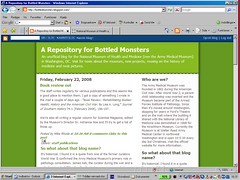In continuation of our earlier (here and here) discussion about ephemeral biomedical objects, I’d like to draw everyone’s attention to the workshop on ‘Scale, Size and the Ephemeral’ at British Museum, next Thursday, 28 February 2008, 1-6pm:
The wealth of models, miniatures and dioramas in museum collections provide collecting paradigms modelled on numismatics and library ephemera. At one level these seem to be forms of ‘easy collecting’, at another they represent best practice. Size and scale give rise to portability, control and management of objects but conversely, allow for compelling evidence of the limitations and fragmentary nature of the collecting process. Moreover, large objects have important expressive functions in terms of place and architectural context, as anchors for museums. Should outsize items, or ephemeral materials such as foodstuffs, plant pith, featherwork and paper ever be collected and stored? Related to this is the question of the natural decay of ephemeral objects. Three-dimensional laser scanning techniques, such as the one now installed at University College London, now have the capacity to record objects in minute detail, over time to document surface decay. Art museums struggle to conserve works of unstable materials; how should anthropology and other cultural museums enter debate around the questions of size and natural decay? This session will explore the conditions under which size, scale and sustainability matter in contemporary collecting.
Speakers include: Dr Victor Buchli (UCL), Paul Cornish (Senior Curator, Exhibits & Firearms, Imperial War Museum), Dr Tom Gretton (UCL), Professor André Gunthert (EHESS, Paris), Susan Lambert (Museum for Design in Plastic), and Calum Storrie (Exhibition Designer, author of ‘The Delirious Museum’). (See here for abstracts)
The workshop is the third in a series of four on ‘Extreme Collecting’ organised in cooperation between British Museum and the program for Teaching and Research Collections at University College London. The series explores collecting practices that challenge the bounds of normally acceptable practice and “apply a critical approach towards the rigidity of museums in maintaining essentially nineteenth century ideas of collecting and move towards identifying priorities for collection policies in UK museums which are inclusive of acquiring ‘difficult’ objects”.
By ‘difficult objects’ they mean, for example, things that “appear so mundane and mass-produced as to appear uninteresting”, or objects which “have physical characteristics—of ephemeral substance, size and scale—that make it impossible to acquire and exhibit or are prone to rapid decay”.
They are currently registering for the last two workshops in the series. Check their website for details and abstracts!
(thanks to Material World for the tip)






